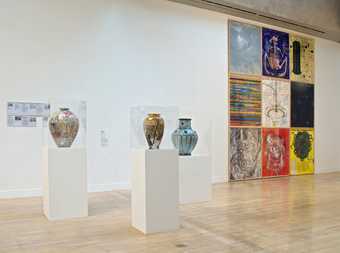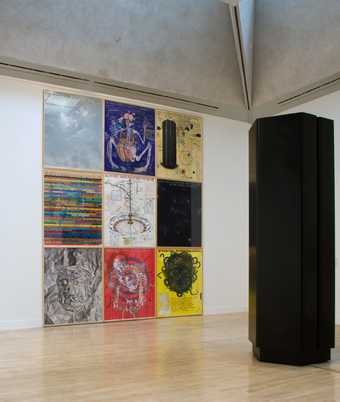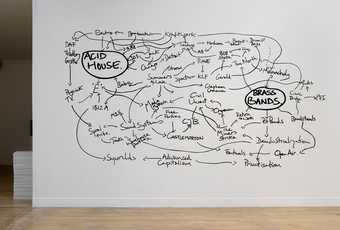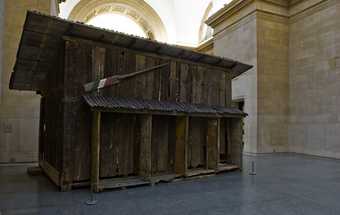
View of Turner Prize: A Retrospective exhibition
Photo: Tate Photography © Tate 2007
During this period there was a conscious attempt to involve members of the public and The Guardian made nomination forms widely available. In 2002 a revamped reading room was introduced inviting visitors to air their views on comments cards. One comment left by government minister Kim Howells even made front page news. He described the works as ‘cold, mechanical conceptual bullshit,’ which sparked debate amongst critics who largely came out in support of the artists.
In 2003 the return to a selection of more established artists was welcomed and Grayson Perry, although a surprise winner, was a popular choice. The 2004 exhibition had a strong political undercurrent reflecting recent world events and the war in Iraq. The inclusion of film by each nominee triggered discussion about the boundaries between video art and documentary filmmaking.
When Jeremy Deller was awarded the prize in 2004 and then Simon Starling in 2005, for two years running the jury prioritised artists whose process-based projects mostly took shape outside the gallery.
Artists and works on display:

Installation by Keith Tyson in the Turner Prize: A Retrospective exhibition
Photo: Tate Photography © Tate 2007
Keith Tyson
All mixed media on paper
Studio Wall Drawing: 21 Nov 2000 – The Seven Wonders (Part II) (Index) 2000
Collection John A Smith and Vicky Hughes
Studio Wall Drawing: 1 .1.2000 – Potential… 2000
Collection Thea Westreich and Ethan Wagner, New York
Studio Wall Drawing: Somewhere Near the Edge of the Visible Universe
Courtesy the artist
Studio Wall Drawing: 24th Feb: A Dissection of the Agonies! 2001
Collection Thea Westreich and Ethan Wagner, New York
Studio Wall Drawing: The Thinker (After Rodin) – Technicals/Notes 2001
Collection Thea Westreich and Ethan Wagner, New York
Studio Wall Drawing: The Mudball Dream aka The Tyre Dream aka The Black Hag 2002
Private Collection
Studio Wall Drawing: August 23rd 2002 – Nikola Tesla’s Third Eye (Mod 37) 2002
Zabladowicz Collection
Studio Wall Drawing: Showing tonight in your cinematic imagination 2002
Rosa and Aaron H. Esman, M.D.
The Thinker (After Rodin) 2001
Enamel sprayed aluminium, steel, computers, software
Collection Thea Westreich and Ethan Wagner, New York
Keith Tyson’s studio wall drawings operate as his sketchbook. Each dated and titled, they are the genesis of all his lines of enquiry and contain proposals, conversations, questions, statements and expressions of his emotional and physical state.
Tyson insists that he is a traditional artist preoccupied with the mysteries of the universe. The Thinker (After Rodin) belongs to a series titled The Seven Wonders of the World, with each work relating to a phenomenon that Tyson finds ‘wondrous’. This monolithic and impenetrable structure is described by Tyson as a ‘comotose god’ and contains a bank of powerful computers that generates its own artificial universe.
Grayson Perry
Golden Ghosts 2001
Earthenware
The Saatchi Gallery, London
We’ve Found the Body of your Child 2000
Earthenware
The Saatchi Gallery, London
A Network of Cracks 2003
Glazed Ceramic
Frank Cohen
Grayson Perry creates seductively beautiful pots that unexpectedly tackle a wide range of personal and social themes. Each ceramic vase is technically accomplished, with decorative glazes combined with collaged text, drawings and evocative ‘found’ photographs that suggest narratives. Perry comments, ‘I want to make something that lives as a beautiful piece of art, but on closer inspection a polemic or ideology will come out of it.’
We’ve Found the Body of your Child investigates the difficult topic of child abuse, underlining that most violence towards children occurs in the home. A Network of Cracks recreates the seating plan of the 2003 Turner Prize award ceremony.

Jeremy Deller
The History of the World 1997–2004
Wall painting
Courtesy the artist and The Modern Institute, Chicago
Jeremy Deller
Memory Bucket 2003
Video, 23mins
Originally commissioned by Art Pace San Antonio
Courtesy the artist, Art Concept, Paris and The Modern Institute, Glasgow
The History of the World 1997-2004
Wall painting
Courtesy the artist and The Modern
Institute, Chicago
Collaboration and participation are central to Jeremy Deller’s work. He acts as curator, producer or director for a broad range of projects, including orchestrated events, films and publications. His practice draws attention to forms of culture on the fringes of the mainstream.
In Memory Bucket, Deller adopts documentary techniques to explore the state of Texas through various encounters during his stay. He focuses on two politically charged locations: the site of the Branch Davidian cult siege in Waco and President Bush’s hometown of Crawford. The work brings together archive news footage with interviews, juxtaposing official media reports with personal narratives.

Simon Starling
Shedboatshed (Mobile Architecture No.2) 2005
Installation view, Turner Prize 2005 exhibition
© Tate 2005
Simon Starling
Shedboatshed (Mobile Architecture No.2) 2005
Mixed media
Kunstmuseum Basel
Simon Starling is intrigued by the processes involved in transforming one object or substance into another. He describes his work as ‘the physical manifestation of a thought process’ and often his projects involve pilgrimage-like journeys.
For Shedboatshed (Mobile Architecture No.2) Starling dismantled a shed and turned it into a boat; loaded with the remains of the shed, the boat was paddled down the Rhine to a museum in Basel where it was once again reassembled as a shed. Starling’s transformations draw out ideas about nature, technology and economics, revealing invisible relationships.
